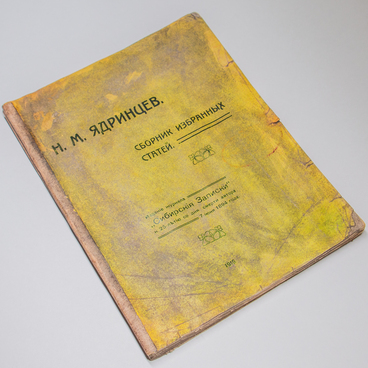The baskets made of birch bark were used to pick up berries, mushrooms, and nuts. If they were airtight and of good quality, people store bulk food and even liquids there: honey, water, milk. Caviar, cucumbers, and mushrooms were salted in big tueses. Before the sale or consumption of food, they were stored in cold cellars.
Tueses were often covered with stamped or carved ornaments. This technique resembled ceramics decoration. Tueses were fixed with the so-called locks: the edges were cut in zigzags, triangles, or rectangles and inserted into the slots on the opposite edge.
The displayed fragment of tues was found during the excavations in Tara — the oldest city of the Omsk Irtysh region. The excavations in Tara started in 2007 led by the Omsk archaeologist Sergey Tataurov. The scientists aimed to discover the exact location of the destroyed Tara temples and to study the Tara fortress. Archaeologists continue their research today and try to find out what the daily and spiritual life of the Siberian Russian city in the 17th century was.
For more than 200 years, Tara was a voivode and uezd center, around which the Russian villages grew.
The city was founded in 1594 by prince Andrey Yeletsky with a detachment of the Cossacks. Tara became the first Russian settlement on the modern Omsk region territory. Tsar Feodor I Ioannovich ordered Yeletsky: ‘to found the city up the Irtysh, on the river of Tara, where the tsar would be more profitable, to start plowing, and to defeat Kuchum Khan, and to get salt…’ But the location in the mouth of the Tara did not suit the construction and agriculture, so the place down of the Irtysh, on the shore of the Arkarka, was chosen to build the city.
Later, the tsar voivodes Yury Shakhovskoy and Mikhail Kaisarov sent the ambassadors with a petition to the tsar Michael Romanov. They asked for permission to build a fortress up the Irtysh by the mouth of the Om. On August 31, 1628, Michael signed a decree on building the fortress, but for some reason, it was not constructed.
Tueses were often covered with stamped or carved ornaments. This technique resembled ceramics decoration. Tueses were fixed with the so-called locks: the edges were cut in zigzags, triangles, or rectangles and inserted into the slots on the opposite edge.
The displayed fragment of tues was found during the excavations in Tara — the oldest city of the Omsk Irtysh region. The excavations in Tara started in 2007 led by the Omsk archaeologist Sergey Tataurov. The scientists aimed to discover the exact location of the destroyed Tara temples and to study the Tara fortress. Archaeologists continue their research today and try to find out what the daily and spiritual life of the Siberian Russian city in the 17th century was.
For more than 200 years, Tara was a voivode and uezd center, around which the Russian villages grew.
The city was founded in 1594 by prince Andrey Yeletsky with a detachment of the Cossacks. Tara became the first Russian settlement on the modern Omsk region territory. Tsar Feodor I Ioannovich ordered Yeletsky: ‘to found the city up the Irtysh, on the river of Tara, where the tsar would be more profitable, to start plowing, and to defeat Kuchum Khan, and to get salt…’ But the location in the mouth of the Tara did not suit the construction and agriculture, so the place down of the Irtysh, on the shore of the Arkarka, was chosen to build the city.
Later, the tsar voivodes Yury Shakhovskoy and Mikhail Kaisarov sent the ambassadors with a petition to the tsar Michael Romanov. They asked for permission to build a fortress up the Irtysh by the mouth of the Om. On August 31, 1628, Michael signed a decree on building the fortress, but for some reason, it was not constructed.



